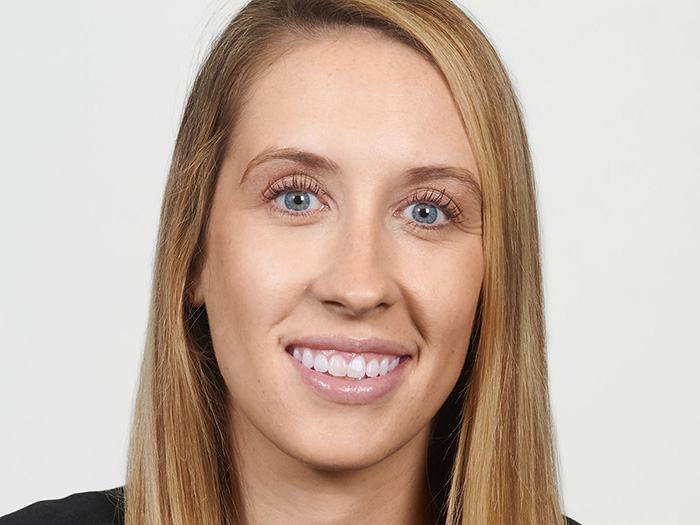Rising Star Kara Patterson Shares Her Take on Decoding Challenges in Real Estate Insurance and Thriving as a Woman Leader


Come see the Stars! As part of our ongoing coverage of the best brokers in the commercial insurance space, Risk & Insurance®, with the sponsorship of Philadelphia Insurance, is expanding its coverage of the Rising Stars — those brokers who represent the next wave of insurance brokering talent.
Look for these expanded profiles on the Risk & Insurance website and in your social media feeds now and continuing into 2023.
Here’s our conversation with Kara Patterson, practice leader at Willis Towers Watson and a 2023 real estate Power Broker winner.
Risk & Insurance: Why did you decide to go into insurance?
Kara Patterson: Like many people in the insurance industry, I landed here by accident. I graduated college in 2010 and during my job hunt my dad put me in touch with a contact at William Gallagher Associates in Boston.
My college internships were in public relations, so I thought I would just try the “insurance thing” for a year to pay the rent with hopes of eventually pursuing a career in PR. Well, 13 years later, I am still here!
As a young professional, jumping into the insurance industry was very overwhelming, but the fast-paced environment and the social aspect of the job was initially appealing. As my experience grew, the constant challenge and wide potential for career advancement has kept me here.
R&I: What are the biggest challenges currently facing the real estate market?
KP: The biggest challenge I consistently face in the current market is a lack of appetite for tougher real estate risks. Especially when it comes to portfolios with habitational exposure, carrier partners who will write business in this space are extremely limited.
In the retail market, carriers are looking for a low percentage of habitational exposure in an overall portfolio, and even then, underwriting guidelines are very strict.
Capacity is also limited in the excess and surplus world, and the markets who will write this type of business have been sublimiting coverages, adding exclusions and deductibles, and consistently giving double-digit rate increases.
It’s difficult to have conversations year after year with clients and give them the news that their insurance costs are going up yet again.
R&I: What have you been doing to help your clients mitigate these issues? Can you give an example of this?
KP: The number one priority for a broker in the real estate market right now is to get creative. With capacity so limited in the habitational space, I have had to look at program structures, engage new carriers and explore different limit and deductible options on client renewals.
I have had several recent renewals where I have separated asset schedules into two separate programs — usually one for the commercial assets and one for the habitational assets.
In the past, I didn’t find this to be a viable option, but in recent years, as the markets’ threshold for habitational risks has significantly decreased, I’ve found that I can keep costs down by seeking competitive options in the retail market on the commercial portfolio while working with a wholesaler on separate options for the habitational assets.
I also believe it’s crucial to have a strong line of communication with your clients. Set expectations early with the insured and be open and up-front about the challenges we are facing in the marketplace. No one is going to be thrilled by increases at any stage of the renewal process, but a client certainly doesn’t want to be surprised by them the day they need to bind.
R&I: Why is the broker integral to an insured’s risk management and insurance program?
KP: Brokers’ relationships with carriers and our knowledge of the ever-changing marketplace are what make brokers a crucial piece of a company’s risk management philosophy. We have a plethora of carrier partners that we are in regular communication with. This not only helps us find the best carrier fit for an individual risk, but our business partnerships give us the ability to create leverage within the marketplace.
At WTW, our leadership has worked with our top carrier partners to pre-negotiate best-in-class coverages specific to different industry verticals, including real estate. Our knowledge of market appetite, rate and coverage changes — as well as what we are seeing as far as losses and claims — allows us to partner with our clients and help them prepare for the challenges they may face over the course of their business operations.
R&I: As a woman, what hurdles have you had to overcome in a male-dominated industry and dealing with “imposter syndrome”?
KP: Imposter syndrome is so real. Even just hearing that someone wanted to write a profile on my experience in the insurance industry, my first reaction was “Why me?”
As women, we are conditioned to be humble and quiet and downplay our accomplishments, so for a lot of us, it takes work to get past the thoughts of not being good enough or experienced enough.
For me, overcoming self-doubt is always a work in progress, but I think time and experience in general, along with the combination of being willing to take on new challenges and projects, has forced me to realize that I am capable.
I try to let my work product and relationships with colleagues and clients speak for [themselves], but I have also learned to have more pride in my accomplishments and remember that I will always be my own number one advocate.
Additionally, I am fortunate to work on a team at WTW that is rich with female leaders. Working side by side and learning from these women has helped change my perception of insurance as a “boys club.” It’s an inspiration to see so many women within my team doing the best possible job for their clients and colleagues on a daily basis and truly excelling within the insurance industry. &










